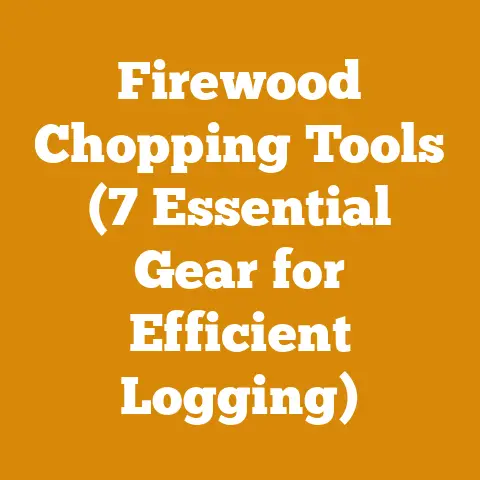Outdoor Forced Air Wood Furnaces (5 Pro Tips for Efficient Heating)
Most of us are thinking about staying warm, saving money on energy bills, and maybe even enjoying the satisfying crackle of a fire. However, a well-maintained and efficient outdoor forced air wood furnace can actually be a surprisingly attractive selling point when you decide to move on. Think of it as an investment in your comfort and your property’s future.
Outdoor Forced Air Wood Furnaces (5 Pro Tips for Efficient Heating)
Introduction: Why Efficiency Matters More Than You Think
For years, I’ve been helping people navigate the world of wood heating. I remember one particular situation: a friend of mine, let’s call him Dave, was constantly complaining about how much wood he was burning. He had an outdoor furnace, but it seemed like he was feeding it non-stop. After a quick assessment, it became clear that he was losing heat like a sieve. His wood wasn’t properly seasoned, his furnace wasn’t insulated well, and his distribution system was leaking heat into uninsulated areas.
Dave’s experience is a classic example of why efficiency is crucial. It’s not just about saving wood; it’s about saving time, effort, and money. Plus, an efficient furnace is a cleaner furnace, producing less smoke and creosote buildup. That translates to fewer maintenance headaches and a longer lifespan for your equipment. So, let’s jump right into the tips I’ve learned along the way that can really make a difference!
1. The Golden Rule: Season Your Wood Properly
This is where the rubber meets the road, folks. Properly seasoned wood is the single most important factor in achieving efficient heating with an outdoor wood furnace. I can’t stress this enough. Green wood is full of moisture, which means a significant portion of the heat generated by your furnace is used to boil off that water instead of heating your home.
Why Seasoning Matters (With Data):
- BTU Output: Green wood can have up to 50% moisture content. This drastically reduces its BTU (British Thermal Unit) output. Seasoned wood, with moisture content below 20%, burns hotter and cleaner.
- Creosote Buildup: Burning green wood creates more smoke and creosote, a flammable substance that can accumulate in your chimney and pose a serious fire hazard. According to the Chimney Safety Institute of America (CSIA), creosote buildup is a leading cause of chimney fires.
- Efficiency Gains: Studies have shown that using properly seasoned wood can increase heating efficiency by as much as 30-40%. That’s a significant saving in both wood consumption and your time spent hauling and splitting.
My Experience: I once tried to get away with burning partially seasoned wood in a pinch. Big mistake. Not only did my house feel colder, but my chimney was coated in a thick layer of creosote within a week. I learned my lesson the hard way.
How to Season Wood Effectively:
- Split it First: Splitting wood increases the surface area exposed to air, accelerating the drying process.
- Stack it Right: Stack your wood in a single row, off the ground, with good airflow. Use pallets or 4x4s as a base. Leave space between rows for air circulation.
- Protect it from Rain and Snow: Cover the top of your woodpile with a tarp or shed roof, but leave the sides open for ventilation.
- Know Your Timelines: Hardwoods like oak and maple typically take 12-24 months to season properly. Softwoods like pine and fir can season in 6-12 months.
- Measure Moisture Content: Invest in a moisture meter. Aim for a moisture content below 20% before burning. You can find these for around $30-$50 at most hardware stores.
Data Points:
- Ideal Moisture Content: Below 20%
- Typical Seasoning Time (Hardwoods): 12-24 months
- Typical Seasoning Time (Softwoods): 6-12 months
- Moisture Meter Cost: $30-$50
2. Optimize Your Furnace Setup and Maintenance
Your outdoor furnace is a complex piece of equipment. Like any machine, it needs proper setup and regular maintenance to perform at its best. Skimping on this step is like buying a high-performance car and never changing the oil.
Key Setup Considerations:
- Proper Sizing: Ensure your furnace is appropriately sized for your heating needs. An oversized furnace will cycle on and off frequently, wasting fuel. An undersized furnace will struggle to keep up during cold snaps. Consult with a qualified HVAC professional to determine the correct size for your home.
- Insulation: Insulate your furnace and underground pipes to minimize heat loss. Use high-quality insulation designed for outdoor use. Check for gaps and cracks in the insulation regularly and repair them promptly.
- Water Treatment: Follow the manufacturer’s recommendations for water treatment. This will prevent corrosion and scale buildup, which can significantly reduce efficiency.
- Chimney Height: Ensure your chimney is tall enough to create adequate draft. A taller chimney will improve combustion and reduce smoke. Check local building codes for height requirements.
- Location, Location, Location: The location of your furnace is critical. Position it in an area that allows for easy access for loading wood and performing maintenance. Also, consider prevailing wind directions to minimize smoke nuisance to neighbors.
Maintenance Must-Do’s:
- Regular Cleaning: Clean your furnace regularly to remove ash and creosote buildup. This will improve combustion and prevent chimney fires. Follow the manufacturer’s instructions for cleaning.
- Inspect and Replace Gaskets: Check the door and chimney gaskets regularly and replace them if they are worn or damaged. Leaky gaskets allow air to enter the furnace, reducing efficiency.
- Check and Adjust Draft: Ensure your draft is properly adjusted. Too much draft will cause the furnace to burn too quickly, wasting fuel. Too little draft will result in incomplete combustion and excessive smoke.
- Inspect and Clean Heat Exchanger: Check the heat exchanger regularly and clean it if necessary. A dirty heat exchanger will reduce heat transfer and decrease efficiency.
- Professional Inspection: Have your furnace inspected annually by a qualified HVAC professional. They can identify potential problems and perform necessary repairs before they become major issues.
My Experience: I once neglected to clean my furnace for an entire season. By the end of winter, it was caked in ash and creosote. Not only was it burning inefficiently, but it was also a fire hazard. I spent an entire weekend cleaning it, and I vowed never to let it get that bad again.
Data Points:
- Annual Inspection Cost: $100-$300 (depending on location and services)
- Insulation R-Value (Pipes): Aim for R-11 or higher
- Water Treatment Frequency: Follow manufacturer’s recommendations (typically monthly)
- Cleaning Frequency: At least once a month during heating season
3. Master the Art of Fire Management
Burning wood efficiently is not just about throwing logs into the firebox. It’s about understanding how to manage the fire to maximize heat output and minimize waste.
Key Fire Management Techniques:
- Top-Down Burning: This method involves lighting the fire from the top down, rather than the bottom up. It promotes cleaner and more efficient combustion. Stack larger logs at the bottom and smaller kindling on top.
- Air Control: Adjust the air intake to control the burn rate. More air will result in a hotter, faster burn. Less air will result in a cooler, slower burn. Experiment to find the optimal setting for your wood and your heating needs.
- Fuel Load: Don’t overload the firebox. Overloading can restrict airflow and lead to incomplete combustion. Add wood gradually as needed.
- Wood Placement: Arrange the wood in the firebox to allow for good airflow around the logs. This will promote more complete combustion.
- Coaling: Allow the fire to establish a good bed of coals before adding more wood. Coals provide a consistent source of heat and help to ignite new logs.
My Experience: I used to just throw wood into my furnace haphazardly. It wasn’t until I started experimenting with different fire management techniques that I really saw a difference in efficiency. Top-down burning, in particular, has been a game-changer for me.
Data Points:
- Top-Down Burning Efficiency Increase: Up to 20% compared to traditional bottom-up burning.
- Ideal Coaling Bed Depth: 4-6 inches
- Air Control Adjustment Frequency: As needed, based on wood type and heating demand.
4. Upgrade Your Wood Processing Workflow
How you process your wood can have a significant impact on your overall efficiency. A streamlined workflow will save you time, energy, and money.
Workflow Optimization Strategies:
- Strategic Planning: Plan your harvest schedule in advance. Determine how much wood you need for the upcoming season and schedule your cutting and splitting accordingly.
- Efficient Felling Techniques: Use proper felling techniques to minimize waste and maximize the amount of usable wood. Consult with a professional logger if you are unsure about felling techniques.
- Log Handling Equipment: Invest in log handling equipment to make the process easier and safer. Log splitters, log lifters, and log carts can significantly reduce the physical strain involved in wood processing.
- Ergonomic Workstation: Set up an ergonomic workstation for splitting and stacking wood. This will reduce fatigue and prevent injuries.
- Organized Storage: Store your wood in an organized manner to make it easier to access and load into your furnace.
My Experience: I used to dread wood processing season. It was back-breaking work. But after investing in a good log splitter and setting up a more efficient workstation, I actually started to enjoy it. It’s now a satisfying way to spend a weekend afternoon.
Data Points:
- Log Splitter Cost: $1,000 – $5,000 (depending on size and power)
- Log Lifter Cost: $200 – $500
- Log Cart Cost: $100 – $300
- Ergonomic Workstation Height: Adjust to your height to minimize bending and lifting.
5. Embrace Technology and Innovation
The world of wood heating is constantly evolving. Embrace new technologies and innovations to improve your efficiency and reduce your environmental impact.
Technological Advancements:
- Smart Thermostats: Install a smart thermostat that can automatically adjust the temperature based on your heating needs. This can save you a significant amount of fuel.
- Combustion Monitoring Systems: Consider installing a combustion monitoring system that provides real-time feedback on your furnace’s performance. This can help you optimize your fire management techniques.
- Wood Gasification Furnaces: Wood gasification furnaces are more efficient and cleaner burning than traditional wood furnaces. They convert wood into a gas that is then burned in a separate combustion chamber.
- Automated Wood Feed Systems: Automated wood feed systems can automatically load wood into your furnace, reducing the amount of manual labor required.
- Online Resources and Communities: Take advantage of online resources and communities to learn from other wood heating enthusiasts. Share your experiences and ask questions.
My Experience: I was initially skeptical of some of the newer wood heating technologies. But after doing some research and talking to other users, I decided to try a smart thermostat. I was amazed at how much fuel it saved me.
Data Points:
- Smart Thermostat Cost: $100 – $300
- Wood Gasification Furnace Cost: $5,000 – $15,000
- Automated Wood Feed System Cost: $2,000 – $5,000
Case Study: Dave’s Transformation
Remember my friend Dave from the beginning? After implementing these tips, his wood-burning experience was completely transformed. He started seasoning his wood properly, insulated his furnace and pipes, and learned how to manage his fire more effectively. The result? He cut his wood consumption by nearly 40%, his house was warmer, and his chimney was much cleaner. He even started to enjoy the process of heating with wood.
Dave’s Results:
- Wood Consumption Reduction: 40%
- Chimney Cleaning Frequency Reduction: From monthly to annually
- Overall Heating Cost Savings: Estimated at $500 – $1000 per year
Addressing Common Challenges
Even with the best planning and execution, you may encounter challenges along the way. Here are some common problems and solutions:
- Wood Waste: Minimize wood waste by using proper felling and bucking techniques. Use smaller pieces of wood for kindling or to fill gaps in the firebox. Consider using a wood chipper to convert waste wood into mulch.
- Smoke Nuisance: Minimize smoke nuisance by burning properly seasoned wood and adjusting your draft. Consider installing a catalytic combustor to reduce emissions. Communicate with your neighbors and be mindful of wind directions.
- Creosote Buildup: Prevent creosote buildup by burning properly seasoned wood and cleaning your chimney regularly. Consider using a creosote remover.
- Corrosion and Scale Buildup: Prevent corrosion and scale buildup by following the manufacturer’s recommendations for water treatment.
- Inefficient Heat Distribution: Improve heat distribution by insulating your ducts and pipes. Consider installing a circulating pump to improve water flow.
Current Trends and Best Practices
The wood heating industry is constantly evolving. Stay up-to-date on the latest trends and best practices to ensure you are getting the most out of your furnace.
- Sustainable Harvesting: Practice sustainable harvesting techniques to ensure the long-term health of your woodlot. Selectively harvest trees to improve forest health and promote biodiversity.
- Renewable Energy Credits: Explore the possibility of earning renewable energy credits for using wood as a heating source.
- Government Incentives: Check for government incentives and rebates for installing energy-efficient wood heating systems.
- Community Wood Banks: Consider participating in a community wood bank to help low-income families access affordable heating fuel.
- Education and Training: Continue to educate yourself on wood heating techniques and best practices. Attend workshops and seminars to learn from experts in the field.
Idioms and Expressions for Wood Heating Enthusiasts
To truly speak the language of wood heating, here are a few idioms and expressions to keep in your back pocket:
- “Cut to the chase”: Get straight to the point.
- “Barking up the wrong tree”: Pursuing the wrong approach.
- “Out of the woods”: No longer in danger or difficulty.
- “A chip off the old block”: Someone who resembles their parent.
- “Burning the candle at both ends”: Working too hard and exhausting yourself.
- “Strike while the iron is hot”: Take advantage of an opportunity while it lasts.
- “Don’t count your chickens before they hatch”: Don’t assume success before it happens.
Takeaways and Next Steps
Heating with an outdoor forced air wood furnace can be a rewarding and cost-effective way to heat your home. By following these pro tips, you can maximize your furnace’s efficiency, reduce your environmental impact, and save money on your heating bills.
Key Takeaways:
- Season your wood properly. This is the most important factor in achieving efficient heating.
- Optimize your furnace setup and maintenance. Regular maintenance will prolong the life of your furnace and improve its efficiency.
- Master the art of fire management. Learn how to burn wood efficiently to maximize heat output and minimize waste.
- Upgrade your wood processing workflow. A streamlined workflow will save you time, energy, and money.
- Embrace technology and innovation. Stay up-to-date on the latest advancements in wood heating technology.
Next Steps:
- Assess your current wood heating setup. Identify areas where you can improve efficiency.
- Develop a plan for implementing these tips. Prioritize the areas that will have the biggest impact.
- Gather the necessary tools and equipment. Invest in quality tools that will make the job easier and safer.
- Start seasoning your wood now for next winter. The sooner you start, the better.
- Join an online wood heating community. Connect with other enthusiasts and share your experiences.
By taking these steps, you’ll be well on your way to enjoying a warm and efficient home this winter. And who knows, maybe you’ll even boost your property’s resale value in the process! Now, get out there and make some heat!






